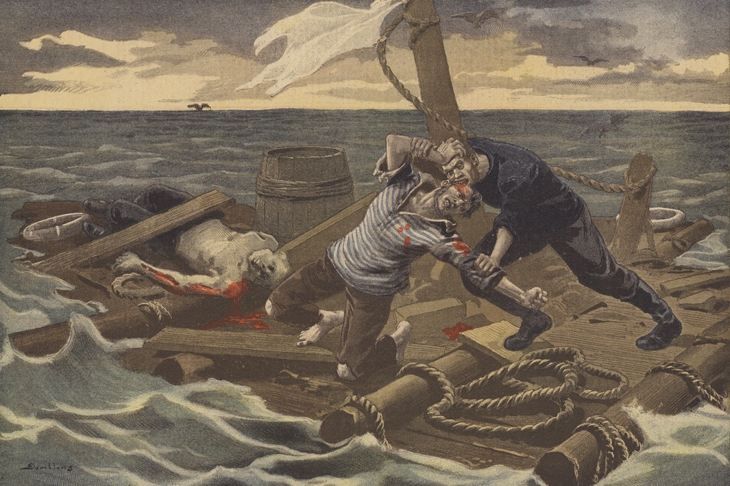This horrifying and engrossing book could scarcely be improved upon. In this age of HRHs Harry, William and Kate-led openness about our mental health, I declare an interest: diagnosed as cyclothymic, and having known more than two attacks of depression and hypomania in the past 30 years, I would have been disqualified from passage as an emigrant to New York by the 1907 US Immigration Act, which prohibited ‘All idiots, imbeciles, feeble-minded persons, epileptics, insane persons and persons who have been insane within five years previous….’
Unfortunately, no Act would necessarily have been enough to prevent me or them from embarking (or being forcibly embarked) on such a ship, and going loopy aboard, according to Nic Compton’s Off the Deep End: A History of Madness at Sea.
Grotesqueries deriving from such regular misadventure, exacerbated by shipwreck, starvation, sinking, scurvy, calenture (heat madness), alcohol or seawater-drinking are partly the plot of this book.
Compton’s subject is mental peril and catastrophe. His book is a lightly-worn but gripping contribution to the field, well researched and full of anecdote and comparison. (You know about Darwin and FitzRoy, but have you heard of the ‘Curse of the Beagle’?) Compton — raised on a variety of boats by his naval officer father, who was torpedoed in 1941— has set himself to study men’s and women’s minds under pressure at sea. As readers of Conrad, Melville and Alistair MacLean will know, the waves reveal the mental processes of mankind like nowhere else.
Advances in mental health care concern many. Treatments have ranged from incarceration in irons and faeces (reported aghast by Dr Burnett, for the Royal Navy, 1840) to ‘the moral management of the patient’ (Burnett again, 1824). On land, we have progressed from Bedlam to Prozac and counselling. But even so, our understanding of mental health may hover near where Nelson’s Navy were with limb trauma at Trafalgar: rum, strap, saw.
Off the Deep End visits the Bounty of Captain Bligh, who had a ‘brief psychotic disorder’); the Whaleship Essex (survivors driven to delirium by dehydration and cannibalism); Columbus (‘hypomanic, increasingly delusional, possibly psychotic’); numerous open boats in which ‘children, foreigners, minorities’ and the weak were eaten; and the international trade in ‘Maniaks’.
Question: if people who are willing to fling themselves into an untried passage to an unknown world are not likely to be slightly batty and at the margins of society anyway, why is New Zealand full of nutters?
The predominance of this fearful malady (insanity) in New Zealand is, perhaps, partly ascribable to the fact that many of those who emigrate to this country are of a romantic and unsettled disposition, and this leads to excesses of various kinds which, I have no doubt, very frequently result in mental disorder.
Thus the Scottish physician William Lauder Lindsay in his 1869 study Insanity in British Immigrants of the Middle and Upper Ranks. Most writers, teachers and health professionals are half way to being New Zealanders by this definition. Compton remarks:
That’s just another way of saying that anyone who was willing to contemplate up to four months at sea in search of a new life must have a spirit of adventure and non-conformity…
So far so good, but then the ship strikes a sandbank, like the Medusa, sailing in 1816 to replace British governance in Senegal with French colonists, and next thing it’s the raft. Two days and nights exposed to the sea and a disproportionate quantity of wine to water lashed aboard a raft carrying 147 produced nightmares of mayhem, murder and that grim ‘custom of the sea’, caught so memorably in Géricault’s famous painting.
To make it more palatable, they hung strips of flesh from the rigging to cook in the sun. It was a scene of utter debasement…Only 15 of the 147 people who had boarded the raft 13 days before were left alive. The rest had all been murdered or washed over the side, or had committed suicide, lost their minds — or been eaten. There was uproar in France when news of the disaster leaked out, and the story soon became a symbol of the corruption of the Bourbon regime.
The second pillar of the plot in this winning book is the use to which individuals and institutions, led by the Royal Navy, have put knowledge of the sea’s madness. Treating mental illness turns oceans to therapeutic effect. Sail training is a life-saver for veterans, the lost and the young, among others.
Inevitably, a trainer recalls a group of young offenders on drugs off Cape Wrath who ‘became quite agitated… we had to talk to them on their level and take an unconventional approach. They were eventually taken off in handcuffs.’ There are hopeful tales too. We have much to learn about charting and navigating mental illness: this is an invaluable almanac.






Comments